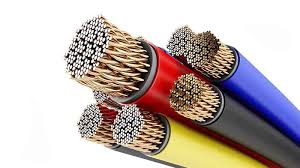
Electrical cables are essential components of any electrical system, enabling the safe and efficient transmission of power and data. Choosing the right cable is crucial for safety, performance, and longevity. In this guide, we’ll explore various types of electrical cables and their applications to help you make an informed decision.
1. Coaxial Cables
Coaxial cables are primarily used for transmitting high-frequency signals. They consist of a central conductor, an insulating layer, a metallic shield, and an outer insulating jacket.
Common Uses:
- Television and satellite communication
- Internet and broadband connections
- CCTV and security camera installations
2. Twisted Pair Cables
Twisted pair cables consist of two insulated copper wires twisted together to minimize electromagnetic interference.
Common Uses:
- Telephone lines
- Local Area Networks (LANs) in homes and offices
- Ethernet networking
3. Fiber Optic Cables
Fiber optic cables transmit data as light pulses through glass or plastic fibers, making them ideal for high-speed and long-distance communications.
Common Uses:
- Internet and data transmission
- Telecommunication networks
- Medical imaging and industrial applications
4. Armored Cables
Armored cables have an extra layer of protection, usually steel or aluminum, to safeguard against physical damage and environmental hazards.
Common Uses:
- Underground power distribution
- Industrial and outdoor wiring
- Harsh environments requiring extra protection
5. Ribbon Cables
Ribbon cables consist of multiple conducting wires arranged in a flat, parallel configuration, making them easy to manage in compact spaces.
Common Uses:
- Computer and peripheral connections
- Internal wiring of electronic devices
- Data transfer in control panels
6. Non-Metallic (NM) Sheathed Cables
NM cables, also known as Romex cables, are widely used in residential wiring. They consist of multiple conductors covered by a plastic sheath.
Common Uses:
- Household wiring for lighting and power outlets
- Indoor applications where moisture protection is not required
- Building electrical systems
7. Underground Feeder (UF) Cables
UF cables are designed for direct burial underground, providing a durable solution for outdoor wiring.
Common Uses:
- Outdoor lighting and garden wiring
- Underground power distribution
- Agricultural and farm installations
8. High-Voltage Cables
High-voltage cables are built to handle significant electrical loads and are used in power transmission and industrial applications.
Common Uses:
- Power transmission in substations
- Industrial machinery and power plants
- Large-scale electrical distribution
9. Thermoplastic High Heat-Resistant Nylon Coated (THHN) Cables
THHN cables are designed to withstand high temperatures and are commonly used in building wiring and industrial settings.
Common Uses:
- Wiring for commercial and residential buildings
- Electrical conduits and raceways
- Industrial control systems
10. Solar Cables
With the rise of renewable energy, solar cables have become essential for connecting photovoltaic systems.
Common Uses:
- Solar panel installations
- Renewable energy systems
- Battery storage connections
How to Choose the Right Electrical Cable
When selecting an electrical cable, consider the following factors:
- Voltage and Current Capacity: Ensure the cable can handle the electrical load.
- Environmental Conditions: Use weather-resistant cables for outdoor installations.
- Flexibility and Durability: Choose cables with protective sheathing for longevity.
- Compliance with Standards: Ensure the cable meets safety and regulatory requirements.
Final Thoughts
Understanding the different types of electrical cables and their uses helps in choosing the right one for your specific needs. Whether for home wiring, industrial applications, or data transmission, selecting the appropriate cable ensures efficiency and safety.
When selecting wires and cables for any electrical project, it is essential to choose the right type based on factors such as voltage capacity, insulation material, and intended application. Whether you need power cables for industrial setups, coaxial cables for data transmission, or flexible wires for home wiring, understanding their specific uses can help ensure safety and efficiency